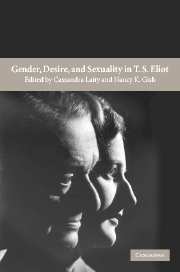Book contents
- Frontmatter
- Contents
- Acknowledgments
- Notes on contributors
- Introduction: Eliot, gender, and modernity
- Part I HOMOEROTICISMS
- Chapter 1 The love song of T. S. Eliot: elegiac homoeroticism in the early poetry
- Chapter 2 T. S. Eliot, famous clairvoyante
- Chapter 3 “Cells in one body”: nation and eros in the early work of T. S. Eliot
- Chapter 4 The masculinity behind the ghosts of modernism in Eliot's Four Quartets
- Part II DESIRE
- Part III MODERN WOMEN
- Index
Chapter 1 - The love song of T. S. Eliot: elegiac homoeroticism in the early poetry
Published online by Cambridge University Press: 22 September 2009
- Frontmatter
- Contents
- Acknowledgments
- Notes on contributors
- Introduction: Eliot, gender, and modernity
- Part I HOMOEROTICISMS
- Chapter 1 The love song of T. S. Eliot: elegiac homoeroticism in the early poetry
- Chapter 2 T. S. Eliot, famous clairvoyante
- Chapter 3 “Cells in one body”: nation and eros in the early work of T. S. Eliot
- Chapter 4 The masculinity behind the ghosts of modernism in Eliot's Four Quartets
- Part II DESIRE
- Part III MODERN WOMEN
- Index
Summary
T. S. Eliot presents the dilemma of an avowedly heterosexual, homophobic writer whose work is obliquely yet significantly marked by homoerotic investments. How is one to understand such libidinal investments? Given the homophobic cultural climate of the twentieth century, what are the conditions under which a man's love for men could be articulated? Same-sex desires, like those for the other sex, are diverse phenomena; they do not spring from a fundamental essence, whose literary representations either obscure or reveal one's true self, but have multiple constituents and diverse manifestations. Moreover, same-sex desires are complexly interwoven with masculine and feminine identifications. Uncovering homoerotic impulses does not unlock the enigma of Eliot's personality, nor are they the hidden truth of his work. Instead of operating as the scandalous key to Eliot's writings, those desires are woven into its fabric and displayed on its most innocent surfaces. Paradoxically, I will argue, the conditions of possibility for Eliot's representation of homoeroticism are precisely the conditions for their disavowal.
The challenge of understanding the homoeroticism of Eliot's work is compounded by the fact that he actively suppressed public discussion of the issue. Although he almost never commented upon interpretations of his work, Eliot censored the only essay to appear in his lifetime that ventured a homosexual reading of The Waste Land.
- Type
- Chapter
- Information
- Gender, Desire, and Sexuality in T. S. Eliot , pp. 23 - 42Publisher: Cambridge University PressPrint publication year: 2004
- 3
- Cited by



